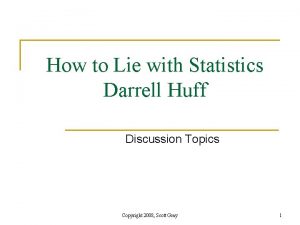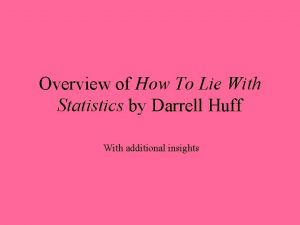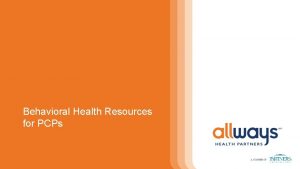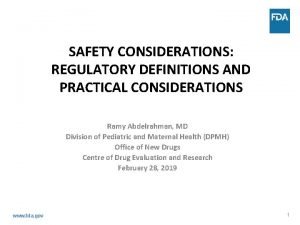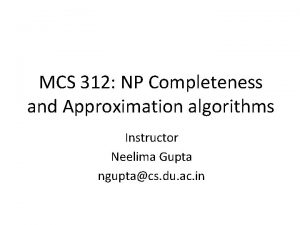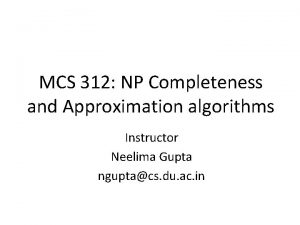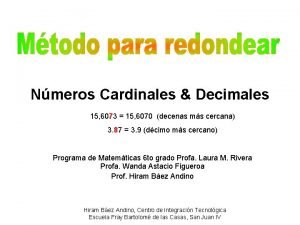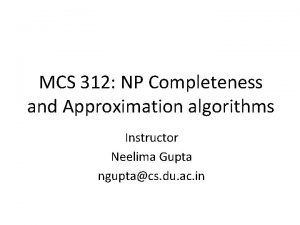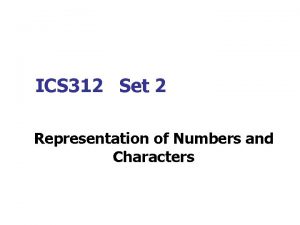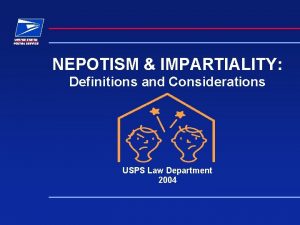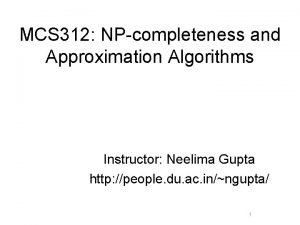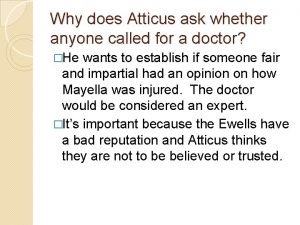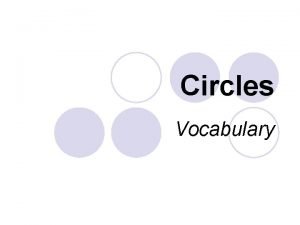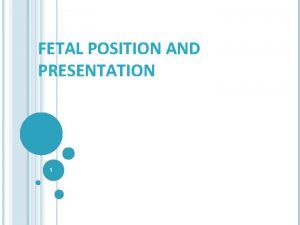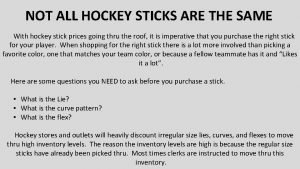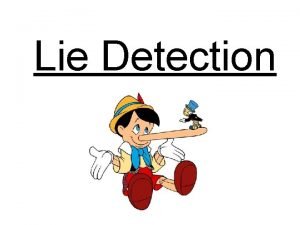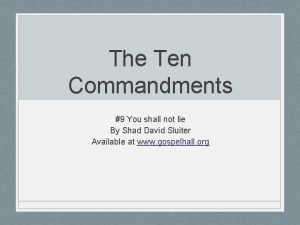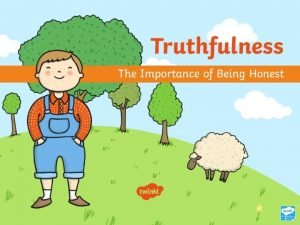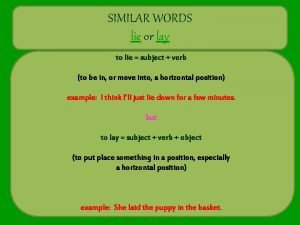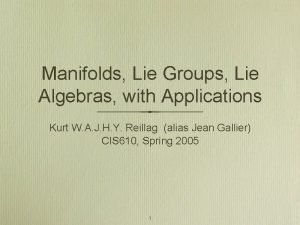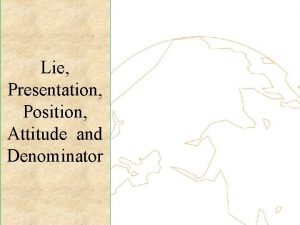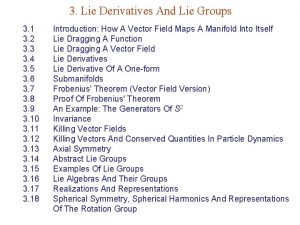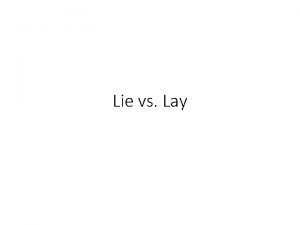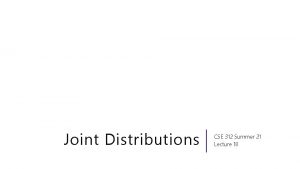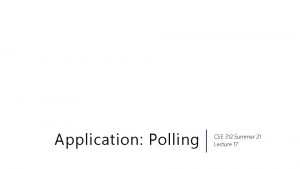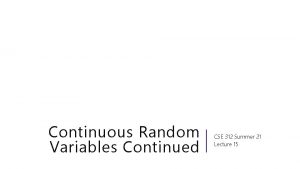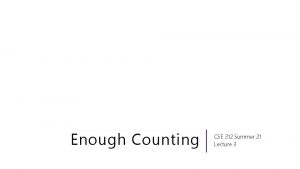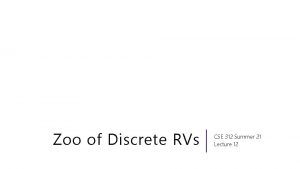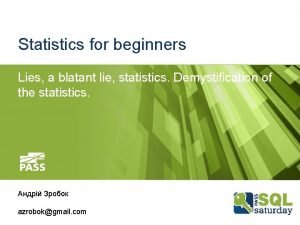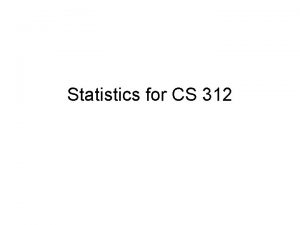How to Lie with Statistics CSE 312 Summer














































- Slides: 46

How to Lie with Statistics CSE 312 Summer 21 Lecture 23

Announcements Upcoming Deadlines : • • • Review Summary 3 Final Released Problem Set 7 Final Key Released Final Interviews – – – Friday, Aug 13 (TONIGHT!) Monday, Aug 16 Tuesday, Aug 17 Wednesday - Friday, Aug 18 - 20 Office Hours will go until Wednesday Use Ed for finals discussions exclusively! No discussion in Office Hours. More logistics posted on Ed as a pinned post later today.

How to Lie with Statistics – Darrell Huff Published in 1954, over 500000 copies sold Doesn’t teach how to lie with statistics, but how we are/can be lied to using statistics In the current age, we are lied to by the media, by politicians, and marketers. • Often make decisions due to it: “ 4 out of 5 dentists recommend…. ” Today’s lecture is heavily inspired by the book and similar examples available on the internet. If you like this lecture, please check out INFO 270 (https: //www. callingbullshit. org/)

What is Statistics? A way to make sense of information from data Framework for thinking, for reaching insights, and solving problems. Numbers alone mean very little without context Statistics is a marriage of: • Math • Science • Art

“Facts are stubborn things, but statistics are pliable. ” ― Mark Twain This Photo by Unknown Author is licensed under CC BY-SA

Friday the 13 th!

Sampling gone wrong (bias)

Sampling Gone Wrong (Bias) “The Literary Digest” Magazine wanted to predict the 1936 election. • Alfred Landon vs Franklin D Roosevelt • Sent 10 million surveys and received 2. 4 million responses • The people contacted were: o Subscribers of the “Literary Digest” o Owners of cars and telephones Electoral Votes Prediction Landon 370 Roosevelt 161 Actual

Sampling Gone Wrong (Bias) “The Literary Digest” Magazine wanted to predict the 1936 election. • Alfred Landon vs Franklin D Roosevelt • Sent 10 million surveys and received 2. 4 million responses • The people contacted were: o Subscribers of the “Literary Digest” o Owners of cars and telephones Electoral Votes Prediction Actual Landon 370 8 Roosevelt 161 523 What went wrong?

Sampling Gone Wrong (Bias) • Not Representative § Voluntary Response Bias o Only 24% of respondents answered the poll § Not the Right Populations o Was biased towards people with more money, education, information, alertness than the average American • Not Random § Convenience Sampling o Only people whose contact information was available o Standing outside a church and asking, “Do you believe in God? ”, and then using the result of this sample to represent the beliefs of the entire US population. More samples is NOT a solution for a bad sampling technique

The “Well-Chosen” Average

The “Well-Chosen” Average

The “Well-Chosen” Average

Are haircuts more expensive in Vancouver or Toronto? Vancouver Saloon Vancouver Toronto $20 1 $20 $15 $20 2 $20 $25 $22 3 $22 $25 $24 4 $29 $25 5 $25 $35 $28 6 $28 $45 $400 7 $400 $65 What do you think?

Are haircuts more expensive in Vancouver or Toronto? Saloon Vancouver Toronto 1 $20 $15 2 $20 $25 3 $22 $25 4 $29 5 $25 $35 6 $28 $45 7 $400 $65 Mean $77 $36 Median $24 $29 Mode $20 $25 What do you think now?

The “Well-Chosen” Average • Mean: Heavily affected/influenced by outliers. Any extreme value(s) may make this measure terrible • Median: About half the values are higher than this, and half are lower than this • Mode: Most frequently occurring value Which one is the best? It depends, and it is good to know all of them for a better idea of the distribution. It is good to know all - mean, median, and, mode - for a better idea of the distribution.

Small Sample Size

Sample Size Too Small Senserdime (toothpaste company) claims 86% of dentists recommend their product. Sounds very impressive. Would you buy a Senserdime toothpaste?

Sample Size Too Small

Sample Size Too Small

Misleading results

Colgate 2007 Ad Campaign In 2007, Colgate advertised that more than 80% of dentists recommended their toothpaste. How would you read this Ad Campaign? • More than 80% dentists recommend Colgate over other toothpaste brands OR • More than 80% of dentists recommend Colgate among other toothpaste brands

Colgate 2007 Ad Campaign • More than 80% dentists recommend Colgate over other toothpaste brands q This may imply that only 20% of dentists recommend toothpaste that are from brands other than Colgate • More than 80% of dentists recommend Colgate among other toothpaste brands q This means that more than 20% of dentists recommend toothpaste that are from brands other than Colgate where a dentist can recommend more than 2 brands


• People who use Senserdime generally have less cavities than those who use generic brands § Can we say “Senserdime prevents cavities”?

• People who use Senserdime generally have less cavities than those who use generic brands § Can we say “Senserdime prevents cavities”? § Turns out that a tube of Senserdime costs $1000. o o This means that only wealthy people can afford it. Wealthy people have access to good healthcare and hygiene They are less likely to get cavities. Therefore, Senserdime did not do anything!

• “When ice cream sales go up, umbrella sales go down”

• “When ice cream sales go up, umbrella sales go down” § Both generally happen in the summer § An increase in ice cream sales did not CAUSE umbrella sales to go down. § The weather CAUSED both of these things to happen Correlation DOES NOT imply Causation!


Conditional Probability

Medical Tests Abbott’s test for COVID-19 is 99% accurate, and we know that 0. 005% of the population has the disease. If you test positive, the probability you have the disease is?

Medical Tests

Biased Carnival? Suppose there is a carnival game which gives out prizes, and three types of players: children, teenagers, and adults. Justin thinks the carnival unfairly gives more prizes to children over the other types of players. Is this true? Player Type % Prizes Won Child 70% Teenager 5% Adult 25%

Biased Carnival? Suppose there is a carnival game which gives out prizes, and three types of players: children, teenagers, and adults. Justin thinks the carnival unfairly gives more prizes to children over the other types of players. Is this true? Player Type % Prizes Won Child 70% Teenager 5% Adult 25%

Biased Carnival? Suppose there is a carnival game which gives out prizes, and three types of players: children, teenagers, and adults. Justin thinks the carnival unfairly gives more prizes to children over the other types of players. Player Type % Prizes Won % Global Population Child 70% 25% Teenager 5% 15% Adult 25% 60% How about now?

Biased Carnival? Suppose there is a carnival game which gives out prizes, and three types of players: children, teenagers, and adults. Justin thinks the carnival unfairly gives more prizes to children over the other types of players. Player Type % Prizes Won % Global Population % Carnival Population Child 70% 25% 71% Teenager 5% 15% 4. 5% Adult 25% 60% 24. 5% This looks very fair now!

Biased Carnival? Player Type % Prizes Won % Global Population % Carnival Population Child 70% 25% 71% Teenager 5% 15% 4. 5% Adult 25% 60% 24. 5%

Simpson’s Paradox

Simpson’s Paradox An analysis of the admission rates for the UC Berkeley grad school in 1973 is a great example of Simpson’s Paradox. Applicants Admitted Men 8442 44% Women 4321 35% Total 12763 41% Was the office of admissions unfair?

Simpson’s Paradox Department Men Women Applicant Admitted s Applicants Admitted A 825 62% 108 82% 933 64% B 560 63% 25 68% 585 63% C 325 37% 593 34% 918 35% D 417 33% 375 35% 792 34% E 191 28% 393 24% 584 25% F 373 6% 341 7% 714 6% How about now? Total

Simpson’s Paradox Simpson's paradox is a phenomenon in probability and statistics in which a trend appears in several groups of data but disappears or reverses when the groups are combined.

Gambler’s Fallacy

Gambler’s Fallacy

How to better understand Statistics? 1. Who says so? 2. How do they know this is true? 3. What’s missing? 4. Did somebody change the subject? 5. Does it make sense?

Conclusions 1. Determine if the samples are random and representative. 2. Ask if the statistic represents the mean, median, or mode. 3. Inquire about the size of the sample relative to the population, and/or ask for a confidence interval. 4. Correlation does not imply causation. 5. Check the distribution of the samples (are they uniform, or not)? 6. Interpret conditional probabilities properly. Intuition sometimes doesn’t work here! 7. Does the data give you the full picture? If there are subcategories, enquire into them! 8. Independent events! Don’t gamble, ever.

“ 95. 73% of all statistics are made up!” - Kushal Jhunjhunwalla This Photo by Unknown Author is licensed under CC BY-SA-NC
 Cse 312
Cse 312 Cse 312
Cse 312 Uw cse 311
Uw cse 311 How to lie with statistics pdf
How to lie with statistics pdf How to lie with statistics chapter 4 summary
How to lie with statistics chapter 4 summary Introduction to statistics what is statistics
Introduction to statistics what is statistics Adding and subtracting integers jeopardy
Adding and subtracting integers jeopardy Po box 30512 salt lake city
Po box 30512 salt lake city Ics 312
Ics 312 The sponsor must submit an ind safety
The sponsor must submit an ind safety Ics 312
Ics 312 Mcs 312
Mcs 312 Mcs 312
Mcs 312 What is the difference between 29 028 and 1 312
What is the difference between 29 028 and 1 312 Sophie nam
Sophie nam 2/9 simplified
2/9 simplified Bus 312
Bus 312 Ee 312
Ee 312 Geog 312 sfu
Geog 312 sfu Ee 312
Ee 312 Flow control instructions in assembly language
Flow control instructions in assembly language Altivar 312 solar
Altivar 312 solar Lebar balok
Lebar balok 123 132 213 231 312 321
123 132 213 231 312 321 Decimo mas cercano
Decimo mas cercano Mcs 312
Mcs 312 Java 8 312
Java 8 312 Brsl
Brsl Ics 312
Ics 312 Ssis 312
Ssis 312 2-312
2-312 El 312 usps
El 312 usps Mcs 312
Mcs 312 History is a lie agreed upon
History is a lie agreed upon Why does atticus ask bob ewell to write his name?
Why does atticus ask bob ewell to write his name? Abaque explosimètre
Abaque explosimètre Make the lie big make it simple
Make the lie big make it simple An angle whose vertex lies on the circle
An angle whose vertex lies on the circle Definition of fetal position
Definition of fetal position Swiss ice hockey shop
Swiss ice hockey shop What rhymes with frog
What rhymes with frog Lay to rest
Lay to rest Mikä on yleispreesens
Mikä on yleispreesens Sleeping freshmen never lie answers
Sleeping freshmen never lie answers History of lie detection
History of lie detection Listen 3.hali
Listen 3.hali Commandments you shall not lie
Commandments you shall not lie



